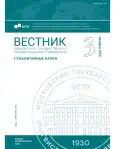Relational Space Construal in the Cinematic Discourse of Science Documentaries
- 作者: Ovagimian N.1
-
隶属关系:
- Moscow State Linguistic University
- 期: 编号 3(884) (2024)
- 页面: 79-85
- 栏目: Linguistics
- URL: https://journal-vniispk.ru/2542-2197/article/view/316177
- ID: 316177
如何引用文章
全文:
详细
The paper presents the methodology and results of the study exploring spatial construal in the speech modality of science documentaries in English. The analysis of the semantic components and the conceptual structure of words in excerpts from popular science films has revealed the inventory and variance of image schemata which mediate relational space construal of different events in the cinematic discourse of science documentaries.
作者简介
Nare Armeni Ovagimian
Moscow State Linguistic University
编辑信件的主要联系方式.
Email: n.ovagimian@yandex.ru
Senior Lecturer Department of English Faculty of Translation and Interpreting Moscow State Linguistic University
俄罗斯联邦参考
- Coëgnarts, M., Kravanja, P. (2012a). From thought to modality: A theoretical framework for analysing structural-conceptual metaphors and image metaphors in film. Image & Narrative, 13(1), 96–113.
- Campbell, V. (2016). Science, entertainment and television documentary. London: Springer.
- Norris, S. P., Guilbert, S. M., Smith, M. L., Hakimelahi, S., Phillips, L. M. (2005). A theoretical framework for narrative explanation in science. Science education, 89(4), 535–563.
- Johnson, M. (1987). The body in the mind: The bodily basis of meaning, imagination, and reason. Chicago: University of Chicago Press.
- Kiose, M. I. (2023). Image Schemas as an Instrument of Multimodal Research. In Germanistika-2022: nove et nova (pp. 136–140). (In Russ.)
- Coëgnaerts, M., Kravanja, P. (2012b). The visual and multimodal representation of time in film, or: How time is metaphorically shaped in space. Image and narrative online magazine of the visual narrative, 13(3), 85–100.
- Belyaevskaya, E. G. (2008). Komponentnyi analiz vs kontseptual’nyi analiz = Componential vs conceptual analysis. Vestnik of Moscow State Linguistic University, 554, 140–146. (In Russ.)
- Bondarchuk, G. G. (2016). Peculiarities in the formation and functioning of English object names. Vestnik of Moscow State Linguistic University. The Humanities, 13(752), 18–25. (In Russ.)
- Myers, G. (1990). Writing biology: Texts in the social construction of scientific knowledge. Madison: University of Wisconsin Press.
- Clausner, T. C. & Croft, W. (1999). Domains and image schemas. Cognitive Linguistics, 10(1), 1–31.
- Evans, V. (2007). Glossary of cognitive linguistics. Edinburgh: Edinburgh University Press.
- Hurtienne, J., Blessing, L. (2007). Design for Intuitive Use-Testing image schema theory for user interface design. DS 42: Proceedings of ICED 2007, the 16 th International Conference on Engineering Design (pp. 829–830). Paris, France, 28–31 July, 2007.
- Cienki, A. (1997). Some properties and groupings of image schemas. Lexical and syntactical constructions and the construction of meaning (pp. 3–15). Amsterdam–Philadelphia: John Benjamins Publishing.
- Lakoff, G., Johnson, M. (1980). Metaphors we live by. Chicago: University of Chicago.
- Onions, C. T., Friedrichsen, G. W. S., Burchfield, R. W. (Eds.). (1966). The Oxford dictionary of English etymology (vol. 178). Oxford: Clarendon Press.
- Klein, E. (1971). A comprehensive etymological dictionary of the English language: dealing with the origin of words and their sense development thus illustrating the history of civilization and culture. Amsterdam, New York: Elsevier Pub. Co.
补充文件










